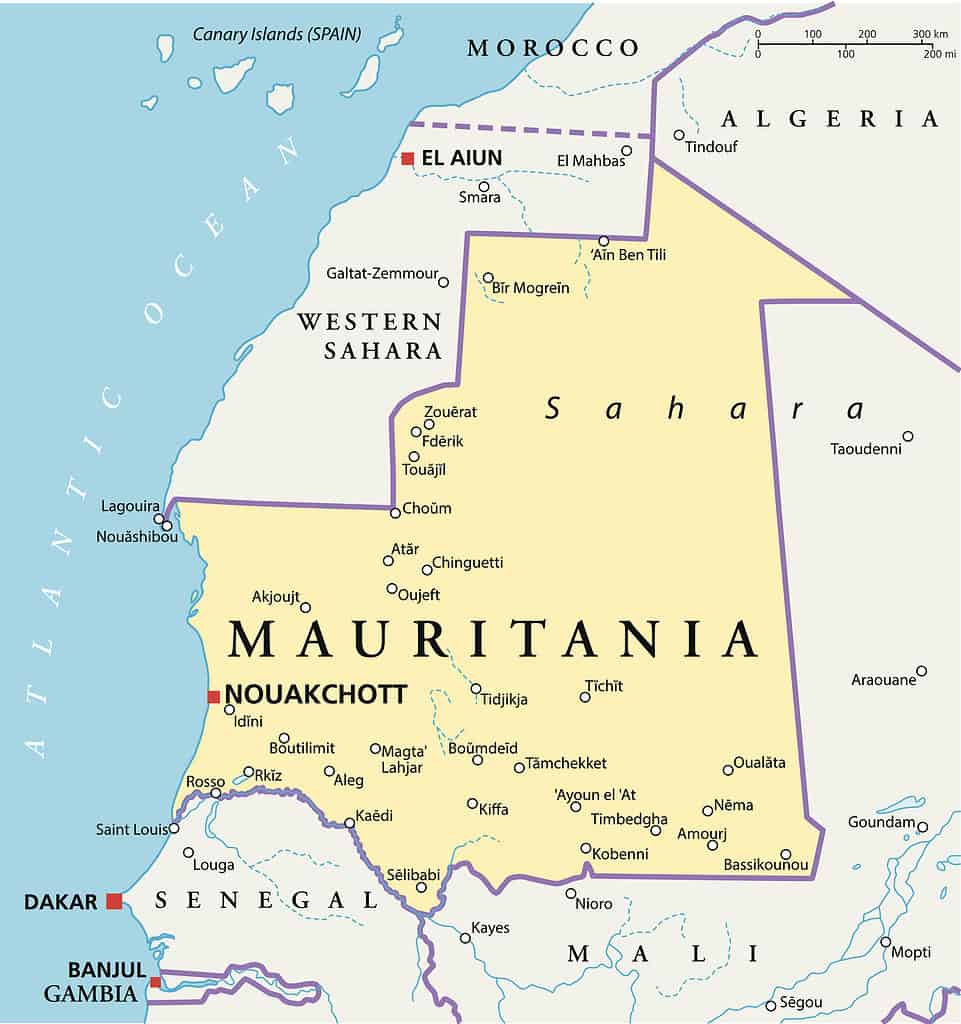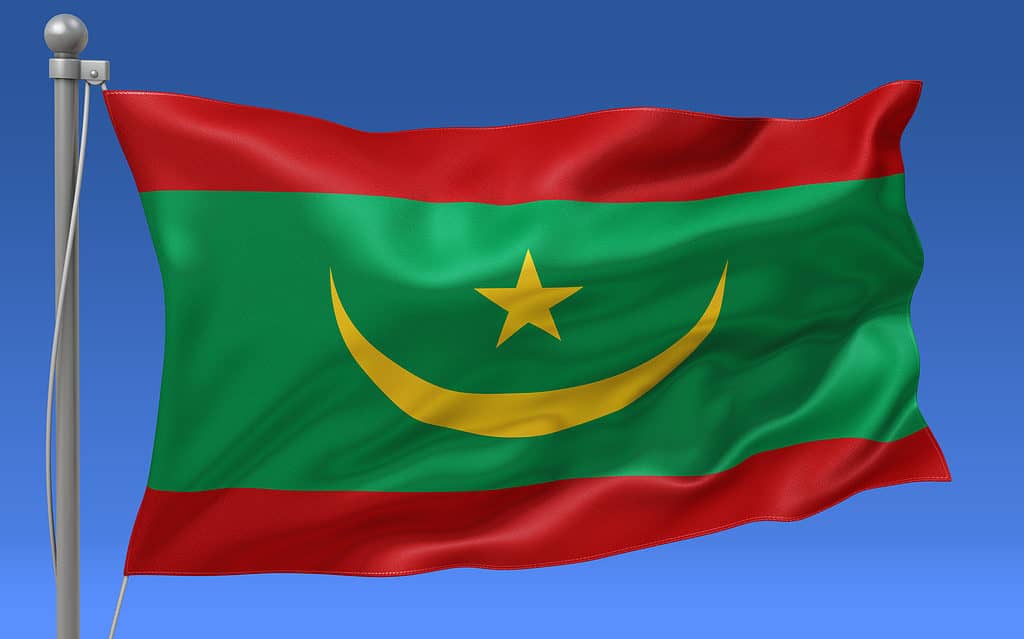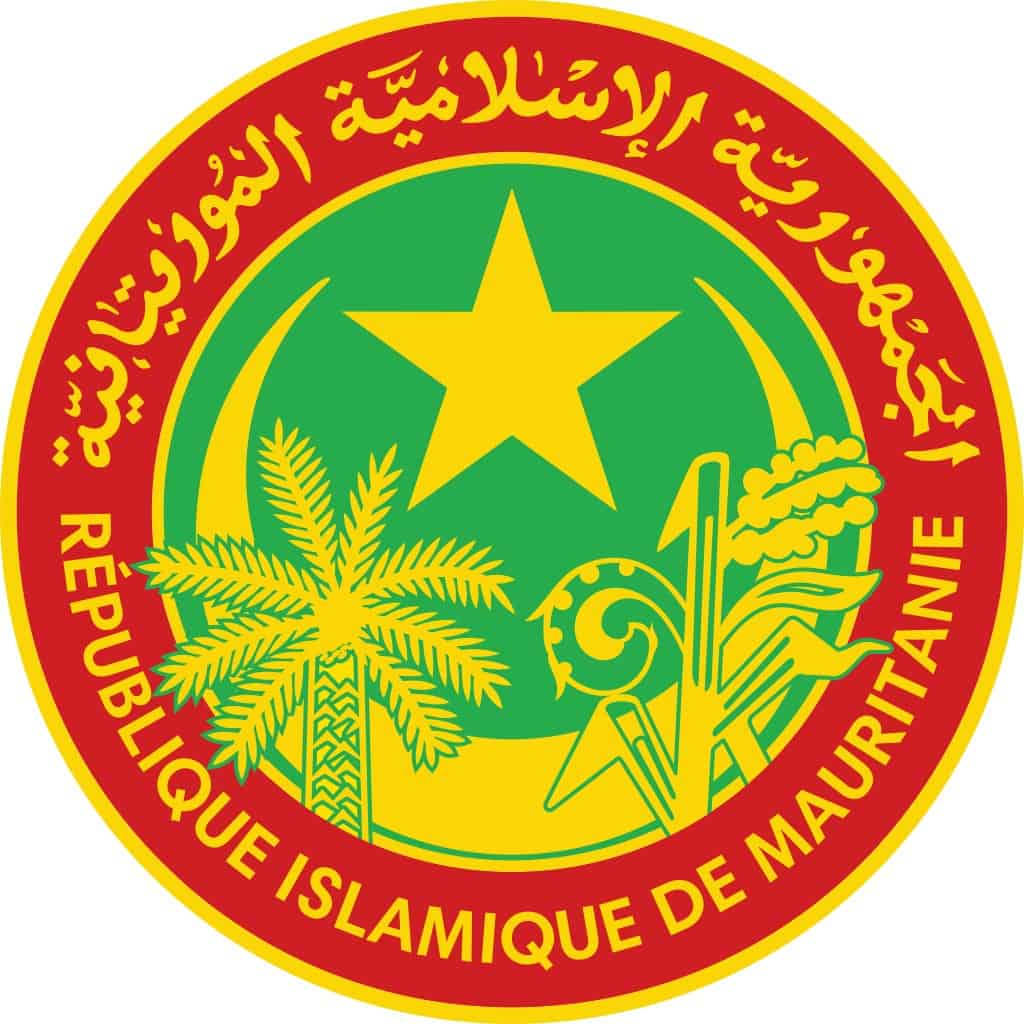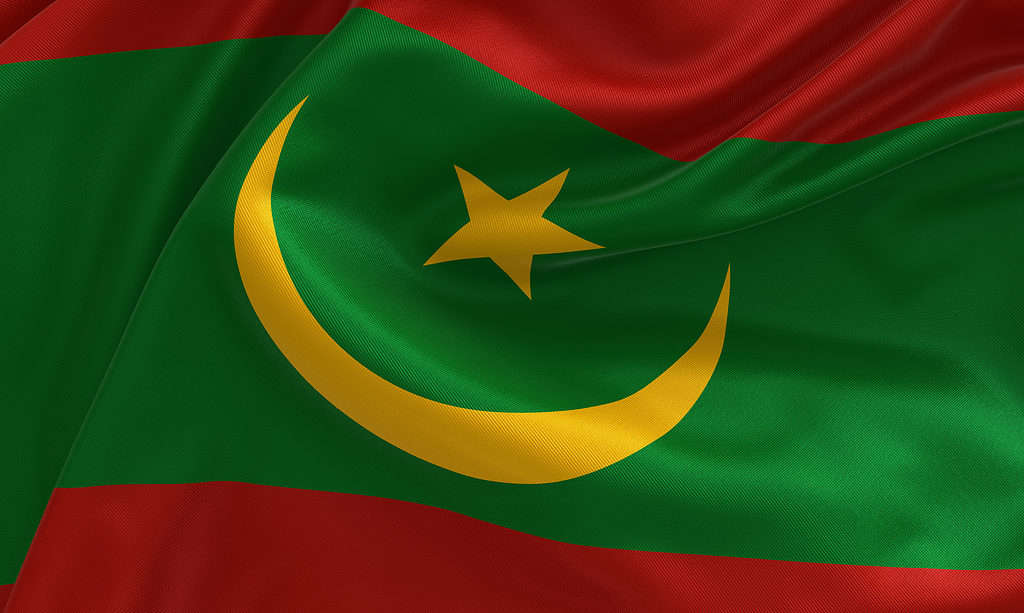A flag is integral to every country. It represents a people’s national values, beliefs, traditions, and their most treasured hopes and dreams for the future. The flag has always played an essential role in inspiring patriotism and loyalty. In addition, it serves as a visible symbol of sovereignty that differentiates one’s country from another.
Although a flag is designed as a colored piece of cloth, the many different ways it can be displayed give it great visual appeal. A nation’s flag has many meanings. It represents historical events, the country’s people, culture, and its official status among other nations.
The current flag of the Republic of Mauritania, adopted in 1960, is one of the world’s simplest yet striking flags. Mauritania was a colony of France from the late 1800s until it gained its independence in 1960.
Today, we discover the history, meaning, and symbolism of the flag of Mauritania.
History of the Flag of Mauritania
Before digging deeper into the details, it’s vital to know about this great country. Mauritania is located in northwest Africa with a population of about 4.775 million and is the 11th largest country in Africa by land mass.
Mauritania is located in the northwest of Africa’s Maghreb region. It borders the Atlantic Ocean to the west, Algeria to the northeast, Senegal to the southwest, and Mali to the east. It also shares a maritime border with the Gambia.
The nation’s name is derived from Mauretania, an ancient Berber monarchy that flourished from 200 BC to 300 AD. Mauritania’s first inhabitants were hunter-gatherers who arrived around 12,000 BC and survived hunting, fishing, and raising livestock. They disappeared from their ancient settlements thousands of years ago, but their descendants have lived in this region for centuries.
The ancient Berber monarchy prospered here from the third century BC. It gave rise to the Roman Province of Mauretania, which flourished up to the seventh century AD.
The Mauritanian flag is a historical symbol of the country’s cultural and political significance to the people and country since its creation. The country’s initial flag colors can be seen in national airlines, post offices, navy ships, and the air force. It’s also found on cars and military installations such as fortifications and aircraft carriers.

Mauritania is located in the northwest of Africa’s Maghreb region bordered by the Atlantic Ocean, Algeria, Senegal and Mali.
©iStock.com/PeterHermesFurian
The French Tricolor
When Mauritania became a French Colony in 1903, the blue-white-red French Tricolor was flown as the country’s first national flag. The flag consisted of three vertical bands of equal width. The flag was named after the colors blue, white, and red.
The French Revolution and the late 18th Century are when the flag’s history began, and the blue has consistently been altered as the times changed. Nevertheless, the French tricolor has become a symbol of French national identity and is recognized worldwide.
The Flag of the Islamic Republic
Following Mauritania’s independence in 1960, a new green flag was chosen. It had a golden crescent moon and a five-pointed star in the center, officially becoming an Islamic republic. The Sahara Desert was symbolized by gold, while the green represents the nation’s progress and the future.
The flag was adopted on November 28, 1960, and has changed with the new government. It was designed by President Moktar Ould Daddah, who wanted a new flag that represented unity and national pride.
It remained in use until August 5, 2017, when a new flag replaced it as part of a series of constitutional and political reforms.

The previous flag of Mauritania, used from 1960 to 2017, did not have the red bands at the top and bottom like in the current flag design.
©iStock.com/sezer ozger
The Current Flag of Mauritania
The current flag of Mauritania is similar to the original flag but with a more simplified design and a different shade of green. It was approved on November 28, 2017, following a victory in a referendum held on August 5, 2017.
Originally intended to be part of a single vote, these amendments ended up being so divisive that they were put up for a new election on the same day as the institutional vote. However, the election resulted in an 86% win where the Mauritanians also abolished their senate.
The referendum was successful, and President Mohamed Ould Abdel Aziz announced that he would abolish the constitution and change other aspects of government institutions.

The current flag of Mauritania was approved by President Mohamed Ould Abdel Aziz on November 28, 2017.
©iStock.com/Nabil Kamara
The Dimensions of the Flag
Although the flag’s dimensions are 2:3, no official standard or building sheet specifies the star and crescent’s (semicircular) exact relative capacity.
The green cover is 60 units wide, while the red stripes are each 20 units. The flag’s yellow symbol is positioned in the center, in a hypothetical rectangle 40 units high and 75 units wide. The gold star plus the crescent covers 67% of the green field.
National Coat of Arms of Mauritania
Mauritania has several official and unofficial symbols that represent its culture in addition to the ones on its flag. The coat of arms of Mauritania is the official national symbol.
The 1959 gold and green national coat of arms was replaced with the current national symbol of unity on August 15, 2017. The seal’s red, green, and gold symbols represent the national flag.
There are two circles on it, and the edges are golden. The country’s name, “Islamic Republic of Mauritania,” is written above and below the seal in both Arabic and French in a red field that divides the inner from outer circles. A star, palm tree, semicircle, and millet branch make up the inner circle.

The coat of arms of Mauritania is the official national symbol.
©Jelloud Najem, Public domain, via Wikimedia Commons – License
Meaning of the Mauritanian Flag
The flag of Mauritania has three colors: red, green, and gold. But what do these colors mean? We find out below.
Red
The red color represents the Mauritanian people’s blood. The top stripe represents the effort and sacrifices that Mauritania’s people will keep making to defend their territory. They will do that at the price of their blood.
The bottom stripe represents unity and sacrifice for the good of all citizens. It also signifies the hardships that Mauritanians have endured to protect their homeland.
Many territorial disputes exist between Mauritania and some of its neighbors in the Sahara Desert. For instance, Morocco’s King Hassan II claimed Mauritania’s independence in 1969 as part of his strategy to acquire control of Western Sahara.
The challenges in suppressing the independence movement of Saharawi, led by the insurgents from the Polisario Front in Mauritania’s share of Western Sahara, led to President Daddah’s retirement. In a military takeover directed by the chief of staff, Col. Mustapha Ould Salek, he was removed from power and forced into exile in July 1978.
After Ould Salek left his position in June 1979, Lieutenant Colonel Mohamed Mahmoud Ould Louly took over. In addition, Mauritania signed an agreement with the Polisario Front in August to distance itself from Western Sahara. The people of Mauritania remember these and many other struggles whenever they look at the red stripes on the flag.
Green
Green is part of the pan-African colors. The green in this national flag also symbolizes Islam, the dominant religion in the arid land of Mauritania. Additionally, in arid areas, green signifies life. According to Prophet Mohammed, green signifies immortality. The green color also represents the country’s agricultural and pastoral traditions and natural resources.
The Pan-African colors on the Mauritania flag are green, yellow/gold, and red. Today, many African countries’ national flags have these colors, which also carry almost identical meanings. The Ethiopian flag is the source of inspiration for the color scheme.
Pan-Africanism is a worldwide movement to promote and strengthen ties and a sense of community among all native people and expatriates of African origin. The movement started with a shared objective that originated with the Atlantic slave trade. As a result, Europeans and the African diaspora comprise a large portion of the pan-African movement’s support base.
Gold
The golden color on the flag of Mauritania represents the country’s desert climate and the region’s location. The golden color in the crescent moon and the five-honed star on the flag’s center are bordered by two green stripes.

The flag’s green symbolizes Islam, gold for the sands of the desert and the red bands represent the fight and sacrifices of Mauritania’s people.
©iStock.com/Nabil Kamara
The Symbolism of the Flag of Mauritania
Mauritania’s flag is based on the national emblem and designed for government and civil organizations. The emblem comprises a shield in the shape of a crescent with a gold star centered on it, representing Islam.
The Star and Crescent
The star and crescent on Mauritania’s flag were also the Ottoman Empire’s symbol. In addition, they have been used in various historical contexts as a prominent symbol of Islam.
In contemporary times they are used as a national symbol for some countries such as Turkey, Egypt, and Azerbaijan. They are also recognized as a symbol of Islam. To Islam, the moon stands for divine direction as one travels through life.
Historically, the crescent and star have been used in various contexts, notably as a critical Ottoman Empire insignia. Similarly, the pan-African flag has a green field with an identically shaped golden star depicted on it.
Other National Symbols of Mauritania
Other important national symbols of Mauritania include:
- The seal of Mauritania
- The national anthem
The Seal of Mauritania
On August 15, 2017, the Mauritanian government announced it would adopt a new national symbol. The president released the seal on September 24, 2017, and officially adopted the new design on October 19, 2017.
The Mauritania national flag, adopted on August 15, 2017, inspired the country’s seal. It has the country’s emblems in red, green, and gold. Arabic and French text around the margins reads, “Islamic Republic of Mauritania.”
The National Anthem
After a referendum to change the constitution in July 1991, Mauritania’s national anthem was approved on November 16, 2017. The previous national anthem (Land of the Proud) was considered almost impossible to sing and was never performed at official events or ceremonies.
The new national anthem is a fusion of two popular songs: One is interpreted as an expression of patriotism and pride in the country’s history, and the other celebrates the founders of modern Mauritania.
Bottom Line
Mauritania’s flag is primarily green with a semicircular shape with a golden star. It has two red bands at the bottom and the top. The first national flag was introduced under President Daddah and the 1959 constitution.
The flag’s gold, red, and green are considered pan-African colors. In addition, green symbolizes Islam, and gold is for the sands of the neighboring desert. The red bands were included in this national symbol in 2017. This represents the fight and sacrifices of Mauritania’s people, who will never stop conspiring to safeguard their borders, even if it means they have to shed their blood.
Mauritania is known for its sizable pastoral population and arid land, with only 0.5% of it arable. But it is also endowed with rich seashores. In 2022, for example, Mauritania amassed slightly over a billion dollars from fishing and employed more than sixty thousand people. In addition, it’s a blessed country with even more natural resources, such as lime and basalt.
Click here to learn about every single flag in the world!
Up Next
- The 10 Countries With Stars On Their Flags, and Their Meaning
- The Flag of Uzbekistan: History, Meaning, and Symbolism
- The Ukrainian Flag: History, Meaning, and Symbolism
The photo featured at the top of this post is © iStock.com/New Vectors
Sources
- France Diplomacy, Available here: https://www.diplomatie.gouv.fr/en/coming-to-france/france-facts/symbols-of-the-republic/article/the-french-flag
- Eurasia Review, Available here: https://www.eurasiareview.com/26052022-discovering-the-amazigh-people-and-their-culture-analysis/
- YALI, Available here: https://yali.state.gov/country-of-the-week-mauritania/
Thank you for reading! Have some feedback for us? Contact the AZ Animals editorial team.






